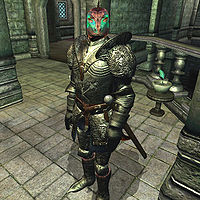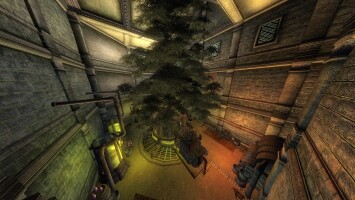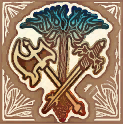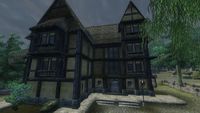Lore:Blackwood Company
The Blackwood Company was a minor mercenary faction that began to operate in the Imperial province of Cyrodiil, out of the city of Leyawiin and the Blackwood Forest, during the latter days of the Third Era, and simultaneous to the Oblivion Crisis.[1]
Initially comprised of former soldiers who failed to reclaim territory in Black Marsh for the Emperor,[2] and comprised almost exclusively of Beastfolk,[3] the Blackwood Company for a while emerged as a notorious yet effective rival and threat to the Cyrodilic chapter of the Fighters Guild, at one point coming dangerously close to tearing the Guild asunder.[1]
Unlike the Fighters Guild, the Blackwood Company had no objection to completing less scrupulous jobs and seemed to operate without moral qualms. Further, unlike the Fighters Guild, there was no limitations as to who could join; even individuals of questionable moral integrity and those with a criminal record could join the group providing that they had combat prowess.[4] Because of this, many Fighters Guild members defected to the Blackwood Company.[5][6] They are notoriously much more reckless when completing contracts for clients. The Blackwood Company has no set of rules & regulations like the Fighters Guild and mercenaries can complete contracts in any way they see fit.[4]
This reckless band of mercenaries was infiltrated by the Hero of Kvatch on behalf of the Fighters Guild in 3E 433. Upon discovering the dangerous secret source of their strength, the Hero of Kvatch destroyed the Blackwood Company's machine which was extracting the sap from a sick Hist tree, and the entire faction along with it.[1]
Contents
History[edit]
Origins[edit]

With origins tied to the jungles and swamps of the province of Black Marsh,[7] and the Blackwood Forest which spans the provinces of Cyrodiil, Black Marsh and Elsweyr, the Blackwood Company were comprised primarily of Khajiit and Argonian mercenaries.[3] The name of the faction was derived from two sources; the Blackwood Forest region, where they were historically most active, and the "thoghatt" or "black charcoal warriors" of Khajiit tradition.[6] The Company was led by a Khajiit "Pakseech" (or 'clan chair') named Ri'Zakar.[8] The Company was initially comprised of mercenaries whom the Emperor hired to reclaim territory in Black Marsh. When they failed this job, they moved to Leyawiin and set up shop there.[2] Members of the Blackwood Company wore a unique set of heavy armor, engraved with the emblem of a sword and axe at the roots of a Hist tree, a reference to the source of their secret strength.[9]
Operations and rivalry with the Fighters Guild[edit]
Circa 3E 432, the Blackwood Company led Imperial excursions along the southern border with Black Marsh in an effort to reclaim territories for the Empire.[2] In response to this, the Argonians staged a hoax outbreak of Knahaten Flu along the border to fight back against these excursions, briefly triggering a panic before the hoax was revealed.[10]
Whereas Cyrodiil's Imperially-chartered Fighters Guild operated by a strict and rigid set of laws, standards and ethics, the Blackwood Company did not, letting it be known that they would accept any contract without moral obligation, and would accept any initiate into their ranks without any screening process and regardless of their past or whether they had a bounty on their heads, and so forth.[4] Although the Fighters Guild considered the Blackwood Company "rank amateurs", this gave the Blackwood Company some obvious advantages over the Fighters Guild, as they could take jobs that the Guild refused and others at a lesser price.[5] The Company were soon expanding by undercutting the Guild in price, and the Fighters Guild began to find themselves short on contracts and struggling to give its members work.[2]
The very existence of the Fighters Guild was jeopardized by the Blackwood Company, with the latter gaining upwards of a hundred operatives at its peak,[11] and setting up their Company Hall across the plaza from the Leyawiin Fighters Guild Hall from which they were stealing most of the contracts. The Guide to Leyawiin, written when the Company first commenced operation there, describes the Company in a very positive light, although it does so for every aspect of the entire city. The Company later expanded their operations, maintaining a remote field headquarters much further into Cyrodiil, in the Great Forest, at Glademist Cave.[12] A dozen Company members manned the Blackwood Company Hall under Pakseech Ri'Zakar, while the mage Ajum-Kajin ran their field operations at the Glademist Cave outpost with ten Company agents.
Despite the fact that there were reports of Blackwood Company mercenaries being reckless and indiscriminate in their methods, and even causing needless damage to person and property during the fulfillment of a contract, the citizenry were wholly unwilling and afraid to make any official complaints against the Company and so no immediate Imperial action was taken against them with the Imperial Legion distracted with the Oblivion Crisis.[4]
When the Fighters Guild was contracted by the wizard Argoth to retrieve the artifact Sinweaver from the renegade Azani Blackheart, fifteen of the twenty-strong party never returned from the unsuccessful mission, including the Guildmaster's son, Vitellus Donton. The Blackwood Company then appeared with Sinweaver, claiming the reward from Argoth; but Argoth himself soon turned up dead, and it transpired that the Blackwood Company had made a counter-deal with Blackheart.[13]
Secrets uncovered and destruction[edit]

During the Oblivion Crisis in 3E 433, the Fighters Guild was spilt in two with the deaths of the sons of the bereaved and withdrawn Guildmaster Vilena Donton, at the hands of Blackwood Company berserkers; with Guild members turning to a demoted Modryn Oreyn. Oreyn made it his priority to uncover the secret of the Blackwood Company's strength, a well-guarded secret within the Company, as evidenced when, during interrogation, Ajum-Kajin committed suicide by equipping the Blackwood Ring of Silence rather than reveal it.[12]
Oreyn tasked the Hero of Kvatch with infiltrating Blackwood Company to uncover the secret of the Company's strength. After reluctantly taking a ritual initiation drink supplied by the Company, the Hero of Kvatch unwittingly took part in the slaughter of the townspeople of Water's Edge, believing the townsfolk to be the very goblins they had been contracted to eradicate. Through this tragedy, the Hero of Kvatch was able to discover that Blackwood Company members used the potent and intoxicating sap from a Hist tree hidden in the secure Blackwood Company Hall basement in Leyawiin.[14]
Blackwood Company members used the sap, often used by master Argonian shaman,[citation needed] to enter a trance-like state, both in ritual and to give them chaotic "bravery" and boost their combat prowess. However, when consumed by a non-Argonian, Hist sap causes hallucinogenic effects which can send the drinker into a bloodlust. Furthermore, the Hist tree that the Blackwood Company used was revealed to have been smuggled directly from Black Marsh, but was sick or corrupted in some way, meaning that the sap caused a crippling dependency that would send even Argonians into murderous frenzies. The Hero of Kvatch gained entry and jammed the elaborate steam-powered mechanism which was in the process of extracting and pumping the sap, which in turn set fire to the tree and the sap stores, after which the Hero killed the remaining Company members. With the threat of the Blackwood Company removed, Vilena Donton retired, her last action to reward these actions by declaring the Hero of Kvatch the new Guildmaster of the Fighters Guild, with Modryn Oreyn to run Guild operations in their stead.[15]
See Also[edit]
- For game-specific information, see the Oblivion article.
References[edit]
- ^ a b c Events of Oblivion
- ^ a b c d Vantus Prelius's dialogue in Oblivion
- ^ a b Guide to Leyawiin — Alessia Ottus
- ^ a b c d A New Guild for Fighters?
- ^ a b Modryn Oreyn's dialogue in Oblivion
- ^ a b Ja'Fazir's dialogue in Oblivion
- ^ Jeetum-Ze's dialogue in Oblivion
- ^ Ri'Zakar's dialogue in Oblivion
- ^ Blackwood Cuirass in Oblivion
- ^ Pocket Guide to the Empire, 3rd Edition: The Seat of Sundered Kings: Cyrodiil — Imperial Geographical Society, 3E 432
- ^ Ajum-Kajin's dialogue in Oblivion
- ^ a b Events of Information Gathering in Oblivion
- ^ Events of Azani Blackheart quest in Oblivion
- ^ Events of Infiltration in Oblivion
- ^ Events of The Hist in Oblivion

